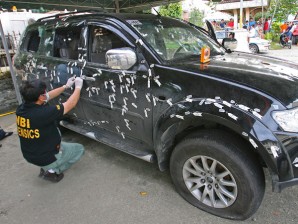Conspiracy eyed in Atimonan shooting

A member of the NBI fornensic team examines one of the bullet riddled SUV at the Municipal Police Station in Atimonan, Quezon where 13 people were killed in an alleged ‘shootout’ with police and military at a checkpoint last January 6.INQUIRER FILE PHOTO/RAFFY LERMA
The National Bureau of Investigation has found that the killing of 13 people at a joint police-military checkpoint in Atimonan, Quezon province, on Jan. 6 was a “conspiracy,” and decided to bring criminal charges against the policemen and soldiers involved.
NBI investigators have also learned from the soldiers who augmented the police team at the checkpoint that police officials allegedly tampered with evidence to make the killings look like the results of a shootout, a source with knowledge of the investigation told the Philippine Daily Inquirer Wednesday.
“There was a clear conspiracy to neutralize the victims, but the charges will be according to the degree of their participation that led to the deaths of 13 people,” an Inquirer source said.
The source, who asked not to be named because he was not authorized to speak to the media, said those directly involved in the killings and were at the checkpoint would be charged as principals, while those who were not at the checkpoint but were part of the conspiracy would be charged as accessories.
The source said the findings were based on examination of the evidence and the testimonies of witnesses, including the soldiers from the Army’s First Special Forces Battalion.
Article continues after this advertisementLocal and provincial police in Quezon reported the incident as a shootout between government security forces and a group of guns for hire.
Article continues after this advertisementLater, it turned out that it was a police operation for the arrest of Victor “Vic” Siman, alleged operator of the numbers racket jueteng in Southern Luzon.
Siman was killed at the checkpoint along Maharlika Highway in Barangay (village) Lumutan, Atimonan, along with 12 other men who were traveling with him. The families of those men claimed there was no shootout and that the victims were summarily executed, prompting President Aquino to order the NBI to investigate.
The NBI investigation is almost over, Justice Secretary Leila de Lima told reporters Wednesday.
De Lima said she was expecting to receive the report on the investigation from NBI Director Nonnatus Rojas anytime.
She declined to confirm reports that the soldiers who took part in the Atimonan operation had been offered to turn state witnesses.
De Lima herself urged the soldiers last week to disclose what they knew, and assured them of government protection.
That must have been arranged, as the soldiers seemed to have cooperated with the NBI investigators.
Tampered with evidence
The source said the investigators learned from the soldiers that police officials tampered with evidence to make the incident look like a shootout.
To do that, the source said, police officials used the firearms of some of Siman’s companions, fired them, then planted them next to the bodies of those men.
The source said the police officials also manipulated the crime scene to show that there was “a heavy exchange of fire.”
“They used the high-powered firearms found with the victims and fired at the concrete [wall] of a closed resort near the crime scene,” the source said.
The source also said the soldiers maintained their claim that the first shot came from the occupants of the first of two sports utility vehicles that carried the victims.
From the testimony of the soldiers, the investigators learned that the response from the government’s side was excessive, the source said.
“One of the soldiers admitted he finished a magazine of his M-14 rifle and reloaded,” the source said.
Standing by men
The Armed Forces chief of staff, Gen. Emmanuel Bautista on Wednesday said the soldiers just did their job and he stood by them.
“Our direction is unity of effort with all security forces to address security issues. Our soldiers, they just do their job. As long as they did their job, there is nothing really to worry about because they did what they thought was right,” Bautista said in a press conference.
Bautista declined to comment on the Inquirer’s report that the Special Forces troops had been offered to become state witnesses.
“I think the justice department or the NBI can answer that,” he said.
Bautista said the military was reviewing the procedures followed by soldiers when police call for augmentation forces in their operations.
Bautista said the police’s notice of request for the Atimonan operation, made by the team of Supt. Hansel Marantan, was “under a tight time frame.”
“There was no time to study the situation. We are reviewing how we can have due diligence given time constraints. We want to be deliberate,” Bautista said.
Marantan was reportedly wounded during the operation. He has been suspended and is facing investigation on the killings.
Only 10 soldiers
Early reports on the incident said 25 Special Forces members supported Marantan’s police team at the checkpoint.
But clarificatory reports established the actual number of soldiers who took part in the operation at 14, as the rest of those deployed stayed behind at the Atimonan police station.
Of the 14 soldiers who took part in the operation, four were assigned to the first of three checkpoints. They did not see the killings, which happened at the second checkpoint. With reports from Nikko Dizon and Christine O. Avendaño
Originally posted: 9:15 pm | Wednesday, January 30th, 2013